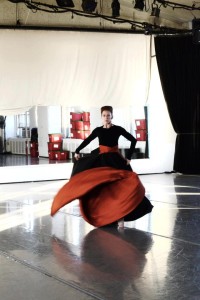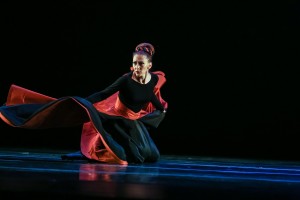“Recreating the Reign, the Better to Fall”
By GIA KOURLAS Published: February 15, 2013
The New York Times
Martha Graham always insisted that she was apolitical, but in 1935 she took a choreographic stand. The solo “Imperial Gesture,” created around the same time she turned down Nazi officials’ invitation to perform at the 1936 Olympic Games, showcased Graham as a monarch demonstrating absolute power before losing control and toppling to the floor.
No film of “Imperial Gesture” exists, only photographs by Barbara Morgan, and the task of reconstructing the piece by the Martha Graham Dance Company has been a daunting group effort. The music, by Lehman Engel, is also missing; in its place is a new composition by Pat Daughtery. But through research the choreographer Kim Jones, a former company member who has staged Graham works, was able to garner a sense of its spirit.
“She was mocking imperialism,” Ms. Jones said in a telephone interview from the University of North Carolina at Charlotte, where she is an assistant professor. “The crowd was jeering about the fall of this character at the end. It was like a rock concert in the 1930s at the Guild Theater. People just rose to their feet.”
As a review in The Dance Observer said, “Here is the essence of the megalomania that conquers continents.”
Just how do you bring a lost solo to life in theatrical terms? For Janet Eilber, the artistic director of the Martha Graham Center of Contemporary Dance, finding that essence is the elusive spark. Examining Graham’s ideas from a new generation’s perspective is a critical part of the reconstruction, just as how small gestures — the exact moment when a dancer turns her head or lifts her eyes — reveal everything.
“We’ve got ego,” she explained in an interview. “But I don’t think we have megalomania yet.”
The Graham company’s season at the Joyce Theater, which begins on Wednesday, features the reanimation of “Imperial Gesture,” performed by the eloquently gutsy Blakeley White-McGuire. The run also includes a reconstruction of “Phaedra” that involves streamlining the work and returning to its original costumes. Since the Graham company lost many of its costumes and sets because of Hurricane Sandy, “Errand Into the Maze,” now called “Errand,” will be performed without the classic sets, costumes, hair and makeup. It’s a first.
But in “Imperial Gesture” the costume is crucial. Designed by Karen Young, the stiff, jewel-tone rust skirt snaps in the front and features panels that can be gathered into a cloak, held high like butterfly wings or lashed violently to accent a defiant stomp. Ms. Jones said, “Really the skirt is a dance partner.”
As with other Graham solos from the 1930s that have been reconstructed with the aid of Barbara Morgan photographs, including “Satyric Festival Song“ (1932) and “Deep Song” (1937), the reanimation project began with 32 images and a smattering of reviews. Ms. Jones worked with the dramaturge Jeanmarie Higgins, also an assistant professor at the University of North Carolina at Charlotte, who found a wealth of descriptive writing in the Marxist publication The New Masses, where the Graham solo was viewed as a potent anti-Fascist statement.
Ms. Jones discovered a diagram of the dance in Merle Armitage’s 1937 book “Martha Graham,” which allowed her to walk through its spatial patterns. From there she met with the former Graham dancers Ethel Winter and Linda Hodes to focus on transitions and the movement vocabulary of the time. In the 1930s Graham had not invented the split falls or the dramatic tilts of later dances like “Diversion of Angels.”
The reanimation team was also guided by John Malcolm Brinnin’s poem “Imperial Gesture for Martha Graham,” which begins with “Clear the courtyard circle of its chalky dusk” and concludes with “Her palms a-click and her quick feet like dice.”
Ms. Jones said: “I thought of images of fancy footwork that European imperialism would have used in court dances, but messing it up and making it more modern, making sure that she uses the different corners of the room, but also acting as if she’s in a round space, where there are people looking down upon her in a courtyard.”
In the solo Ms. White-McGuire’s arms fold in like broken wings and her feet strike down hard; brisk claps and finger snaps emphasize the character’s demonic fervor. But just how to begin the dance posed a challenge; Ms. Jones had to abandon the spatial diagram, in which an arrow pointed from wings to stage. “In the ‘30s Graham didn’t walk onto the stage,” Ms. Jones said. “She was discovered on the stage. So that’s where we had to start.”
After the research part of reimagining a dance has to do with intuition. The rest comes down to fine-tuning. Recently at Westbeth, the company’s rehearsal studios in the West Village, Ms. Eilber watched as Ms. White-McGuire crossed the floor with sharp stomps before whipping the fabric of her skirt with maniacal force.
“Can you put a turn on that last step?” Ms. Eilber asked.
The movement phrase, punctuated with an emphatic swirl, suddenly became an expression of haughty contempt. “She’s got a lot of attitude,” Ms. White-McGuire exclaimed.
Ms. Eilber laughed and said, “We have to get her up high, so she has farther to fall.”
The tension in “Imperial Gesture” and the use of a controlled fall at the end are traditional Graham. “But I think there might be a little bit of spunkiness in there that might not be so Graham,” Ms. White-McGuire said in an interview. “My monarch is feisty, and Graham, from what I know and have studied, was very regal. Now I want, of course, the regal. But there’s also Blakeley White-McGuire in there. I don’t want to negate my tendencies and my dynamics.”


